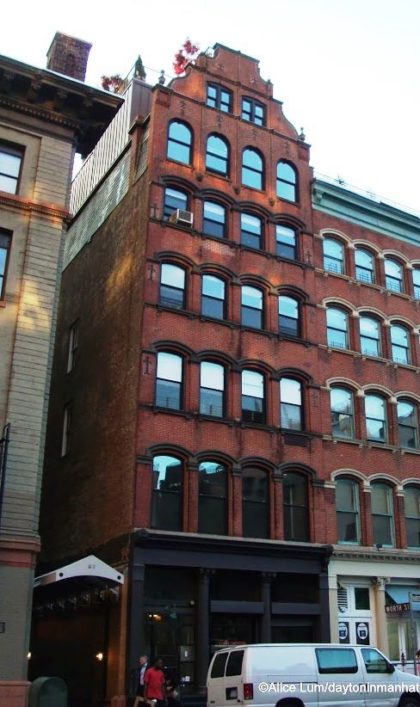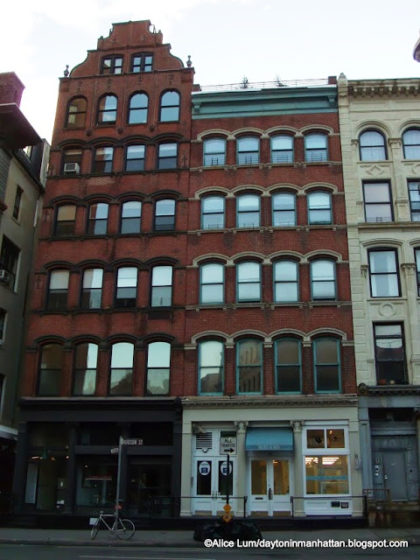The History of 71 Hudson
 Tom Miller, who writes about the history of Manhattan buildings at Daytonian in Manhattan, has allowed Tribeca Citizen to create a database of his Tribeca posts. If you enjoy these, and you will, then you should definitely check out his website, which also has write-ups about buildings all over the island. And don’t miss his book, Seeking New York: The Stories Behind the Historic Architecture of Manhattan—One Building at a Time.
Tom Miller, who writes about the history of Manhattan buildings at Daytonian in Manhattan, has allowed Tribeca Citizen to create a database of his Tribeca posts. If you enjoy these, and you will, then you should definitely check out his website, which also has write-ups about buildings all over the island. And don’t miss his book, Seeking New York: The Stories Behind the Historic Architecture of Manhattan—One Building at a Time.
··································
 By the 1880s the area around the Washington Market was home to New York’s wholesale and retail food dealers. The district now known as Tribeca filled with brick loft and store structures, often built for the prevalent dairy and produce businesses centered here—the “egg and butter” trade.
By the 1880s the area around the Washington Market was home to New York’s wholesale and retail food dealers. The district now known as Tribeca filled with brick loft and store structures, often built for the prevalent dairy and produce businesses centered here—the “egg and butter” trade.
In 1867 a handsome five-story structure was completed at No. 73 Hudson Street. Four floors of red brick sat upon a cast iron base with fluted Corinthian columns. Thirteen years later developer David Martin hired Amzi Hill to design a loft building next door at No. 71. The architect’s job was simple: reproduce No. 73.
Like its next door neighbor, the new Italianate-style building stretched through the block to Staples Street. The cornices, stringcourses and openings lined up so perfectly that the passerby, in 1880 or today, would hardly suspect the two buildings were not built simultaneously as a pair.
Five years after construction, the building was purchased by merchant William T. Coleman. Coleman had fronted the funds to established William T. Coleman & Co. on New Year’s Eve 1883. His year-old firm now had its own building.
Coleman had other tenants, as well. In 1888 Delafield, Morgan, Kissell & Co, dealers in canned fish and canned fruit, operated from here. The firm was also an agent for a more unusual product—the “Downie Eucalyptus Boiler Scale Preventive and Remover.” The company’s advertisements touted, “This extract, from the leaves of the Eucalyptus tree, has been adopted and is now in use by most of the American S.S. lines, the U.S. Navy, and the largest stationary plants in the country.”
That same year William T. Coleman & Co. was sued by the Bank of British North America for $25,000; a problem that may have contributed to Coleman’s selling No. 71 Hudson Street.
Prior to the Civil War in Wolcottville, Connecticut, Gail Borden established a small factory to produce his invention—condensed milk. In 1858, Jeremiah Milbank financially backed his operation and the New York Condensed Milk Company was formed.
The once-tiny operation, boosted by the convenience of condensed milk during the war, was a thriving business in 1889. The company purchased No. 71 Hudson Street as a milk warehouse for its product and that of its related company, the Borden Condensed Milk Company.
In the last years of the 19th century Flemish Revival-style structures began dotting Manhattan—a nod to the city’s Dutch roots. The New York Condensed Milk Company joined the trend when it commissioned Dehli, Chamberlin & Howard to add two stories to the building in 1896. The architects transformed the Italianate structure to a Flemish one by the addition of a curving two-story gable.
The brick façade was painted a light color, as was No. 73, and decorative iron masonry supports were added to update the design. An early photograph shows wide panels, stretching the width of the structure, affixed below the third, fourth and fifth floors.
On December 24, 1897, New York Condensed Milk Company secretary William R. Rogers commented in The New York Times about the historic milk market in New York. “New York was the largest milk-producing State in the world, and it produced enough milk to supply the entire United States, provided that all the markets over the country could be reached. Those farmers who could not find a market for their milk in this city made it up into butter and cheese.”
In 1899 the New York Condensed Milk Company was succeeded by the Borden Condensed Milk Company which continued to expand. On August 1, 1902, the New-York Tribune reported, “By the purchased of the American property of the Anglo-Swiss Condensed Milk Company, the Borden Condensed Milk Company of No. 71 Hudson-st., has added another important establishment to its organization.”
At the same time the company supplied the United States Navy with condensed milk—a lucrative contract that would last several years.
Also in the building in 1905 were the James M. Bell Company, wine importers, and F. O. Boyd & Co., dealers in California wines. Gustave F. Speckel and his 28-year old son, Henry George Speckel, were involved with both companies; Gustave being vice-president of James M. Bell and Henry being secretary.
Things seemed to be going well for Henry Speckel. He was married in August 1905 and he was earning an enviable salary. But in November he contracted typhoid fever, a condition that threw him into depression.
At 4:45 on the evening of November 20, Mrs. Speckel noticed her husband’s overcoat and black derby were missing from the hallway rack. Concerned, she telephone her father-in-law and after a visit to several neighboring houses, Speckel notified the police.
Mrs. Speckel said her husband was “in a disturbed condition of mind,” and described his dark suit and tan shoes. He had, she said, no money when he left home.
Six days later Gustave Speckel offered a $250 reward for information leading to the discovery of his son. But despite earnest attempts the young man could not be found—until May 8 the following year.
The New-York Tribune reported that “The body of the man found in the Hudson River, near the Spuyten Duyvil Bridge, on Sunday, was identified yesterday as that of Henry George Speckel, a wine merchant, twenty-nine years old, of No. 856 Riverside Drive.”
The newspaper added, “An attack of typhoid fever had left him subject to melancholia, and his father says he must have drowned himself while insane.”
 Until 1896 the two buildings were identical.
Until 1896 the two buildings were identical.
··································
By the 1930s, the building was owned by the Carnation Milk Products Company, which occupied the upper floors. The Mohawk Condensed Milk Company took up the first three floors. The building was the scene in 1931 of a disastrous three-alarm fire.
For two hours on August 21 firemen battled the fire. NYFD Captain Augustine O’Connor of Hook and Ladder Company No. 1 suffered what The New York Times called “an apoplectic stroke” while directing his men. He “was removed to Beekman Street Hospital where it was reported that he was paralyzed from the waist down and unable to speak.” Two other firemen were slightly injured in fighting the blaze.
In 1937 Joseph J. Herold, Jr., purchased the building from the Carnation Company for just $23,000—less than half of what it had cost to repair the damages from the fire six years earlier.
As the 20th century drew to a close, the Tribeca area changed from one of warehouses and small factories to a trendy neighborhood of upscale restaurants and luxury apartments. In 1984 No. 71 Hudson Street was converted to “loft dwellings,” one enormous residence per floor. In was here, in August 1989, that John F. Kennedy, Jr., lived in a sub-leased apartment.
Although the Flemish gable has been slightly decapitated, the rest of No. 71 is astoundingly intact—right down to the original cast iron base. The 1896 renovation that took the building from handsome to picturesque still makes it a standout on an architecturally-interesting block.
··································
Photo credits: Alice Lum.












